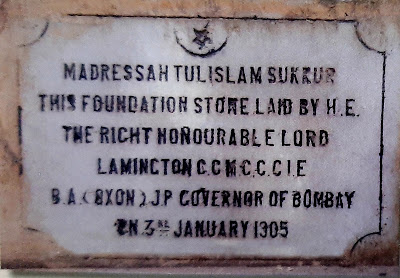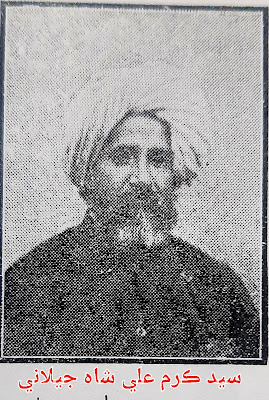The Sukkur Madrassa Boarding House: A Historical Journey to Agha Nizamuddin Girls College
 |
| The foundation stone plaque of Madressah Tul Islam Sukkur, laid by the Right Honourable Lord Lamington, Governor of Bombay, on January 3rd, 1905. |
Nestled in the vibrant city of Sukkur, Sindh, stands a building that encapsulates over a century of educational heritage. Originally constructed as the Sukkur Madrassa Boarding House in 1911, this historical landmark has transformed into the Agha Nizamuddin Girls College, serving as a vital educational institution for women. This article explores its rich history, architectural evolution, key figures involved, and its enduring significance as a symbol of education in Sindh.
Understanding Madrasas: A Historical Context
Madrasas, meaning "schools" in Arabic, have long been pillars of education in the Islamic world. Beyond religious instruction, many madrasas provided secular learning and residential facilities for students. The Sukkur Madrassa Boarding House emerged from this tradition, offering Muslim students a place to live and study while attending the nearby Municipal High School, now Government High School on Minara Road, Sukkur.
The Early History of Sukkur Madrassa Boarding House
 |
| A photograph of a boarding house from the 1940s, showcasing its architectural design with two levels of arches and brick construction. |
The foundation of the Sukkur Madrassa Boarding House was laid in 1905, a pivotal moment in Sukkur’s educational history. According to Tarikh Sukkur by Rahim Dad Khan Molaei Shidai, the foundation stone was placed by Jean Louis Rieu, the Collector of Sukkur at the time. However, a marble plaque on the building attributes the ceremony to Baron Lamington, Governor of Bombay, on January 3, 1905. This dual recognition likely reflects the collaboration between local and provincial authorities.
In 1906, the District Madrassa Board was formed to oversee the project. Prominent members included Khan Bahadur Pir Bakhsh, Abdul Rahman Pirzado (father of Sindh Chief Minister Abdul Sattar Pirzado and grandfather of lawyer Abdul Hafeez Pirzado), Pir Karim Ali Shah, and Master Habibullah. Their efforts culminated in the completion of the boarding house in 1911, providing a two-story residence and mosque for students.
Construction and Architectural Features
Construction of the Sukkur Madrassa Boarding House began with a single-story structure, completed in 1911 at a cost of Rs. 17,236. In 1941, a second floor was added for Rs. 6,750, expanding its capacity. The building included a mosque, reflecting its dual role as a residential and spiritual hub. While detailed architectural descriptions are scarce, its colonial-era design aligns with the functional aesthetics of educational buildings in early 20th-century Sindh, likely featuring high ceilings and a practical layout.
The land was originally a municipal plot allocated in 1903, highlighting the community’s commitment to education. This investment paid off as the boarding house became a cornerstone of Sukkur’s educational landscape.
Key Figures Who Shaped Its Legacy
The Sukkur Madrassa Boarding House owes much to its visionary founders. Khan Bahadur Pir Bakhsh was a leading advocate for education in Sukkur. He also presided over Anjuman Islam, founded in 1898 by Pir Ghous Ali Shah Jilani to promote Muslim education and welfare. Following Pir Ghous Ali Shah’s death in 1905, his nephew Pir Karim Ali Shah attempted to establish a rival Anjuman Islam in 1910 but failed due to Khan Bahadur Pir Bakhsh’s influence.
Abdul Rahman Pirzado and other board members also played critical roles, ensuring the project’s success. After Khan Bahadur Pir Bakhsh’s death in 1935, his son Mian Rahim Bakhsh took over Anjuman Islam, though it faced challenges from figures like Pir Ali Muhammad Rashdi and Rahim Dad Khan Molaei Shidai.
Transformation into Agha Nizamuddin Girls College
The building’s purpose evolved over time. It remained under the Sindh Madrassa Board until 1960, then affiliated with Government High School until 1962. From 1962 to 1967, it operated as a government college. In October 1968, the management board established Aga Nizamuddin Girls College within its walls, marking a shift toward women’s education. The adjacent Sindh Madrassa Board Girls School, also under the same board, was nationalized by the government in 1972 alongside the college.
This transformation reflects broader societal changes in Sindh, emphasizing access to education for women and the adaptive reuse of historical structures.
Current Status and Preservation Efforts
Today, Agha Nizamuddin Girls College continues to educate young women within this historic building. Recent reports indicate that the upper portion’s roof has undergone repairs, signaling ongoing efforts to maintain its integrity. As a treasured piece of Sukkur’s historical capital, the building stands as a testament to the city’s educational legacy.
Preserving such landmarks is essential. Experts in architecture and heritage conservation should be engaged to restore the building to its original form, ensuring its historical value endures for future generations. This balance of functionality and preservation keeps the spirit of the Sukkur Madrassa Boarding House alive.
The Broader Educational Landscape in Sukkur
The boarding house was part of a vibrant educational scene in early 20th-century Sukkur. The Sukkur District Local Board, as noted in historical accounts, supported various initiatives, while the city’s diverse communities Muslims and Hindus lived harmoniously, fostering a culture of learning. This context underscores the boarding house’s role in a larger movement to advance education in Sindh.
Conclusion
From its origins as the Sukkur Madrassa Boarding House to its current incarnation as Agha Nizamuddin Girls College, this building embodies a remarkable journey of adaptation and resilience. It honors the vision of its founders Khan Bahadur Pir Bakhsh, Abdul Rahman Pirzado, and others while meeting modern educational needs. By safeguarding this historical treasure, Sukkur preserves a vital link to its past and a foundation for its future.
References
Molaei Shidai, Rahim Dad Khan. Tarikh Sukkur.
The Top 5 Historic Sites in Rohri You Can’t Miss! - www.rohri.net
Old Sukkur Panchayat - History of Sukkur - oldsukkur.org
Madrasa | Encyclopedia.com - www.encyclopedia.com
Madrasa - Wikipedia - en.wikipedia.org
Sayed Imdad Hussain Shah Rizvi. Personal communication or unpublished record.
Post: Sayed Sajjad Hussain Musavi
© 2025 Discover Rohri The Ancient City of Sindh
#sukkurhistory #sindhheritage #educationinsindh #historicallandmarks









No comments:
Post a Comment